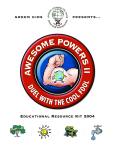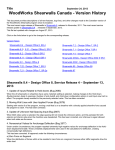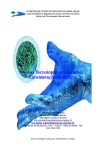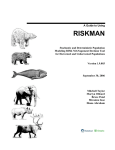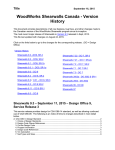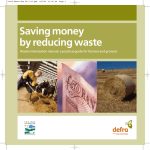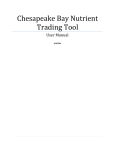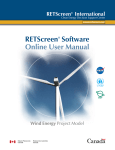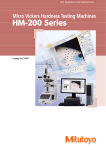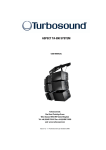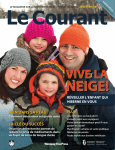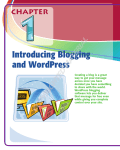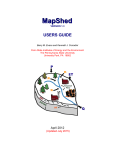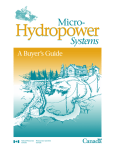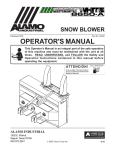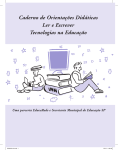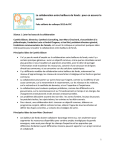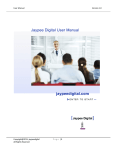Download Ebb & Flo - Green Kids Inc
Transcript
THANKS TO ALL OUR SPONSORS 1 TABLE OF CONTENTS Thanks to our supporters…………………………….……………………………1 About Green Kids This year’s show: Ebb and Flo: The Water Cycle………………………………4 Director’s Note……………………………………………………………………...5 Using our Kit………………………………………………………………………...7 Terms to Know and Teach………………………………………………………...8 Lessons Getting Started Quiz………………………………………………………………13 The Water Cycle………………………………………………………….……….16 Activity: Name that step of the Water Cycle…………………………………...17 Activity: Investigate the Water Cycle……………………………………………19 Why Water?...................................................................................................20 Activity: Water in the World Quiz………………………………………………..21 Water in Your Life………………………………………………………………...23 Activity: How much water do you use?..........................................................24 Water and Weather…………………………………………………………….…26 Activity: Water in the weather…………………………………………………...27 Water at Work: Agriculture……………………………………………………….29 Activity: Grow your own tomatoes!................................................................31 Water at Work: Hydroelectricity………………………………………………....33 Activity: Energy, are you doing your part?.....................................................35 Water Pollution…………………………………………………………………....39 Activity: Who polluted the Red River?...........................................................42 Activity: In Hot Water……………………………………………………………..44 Resources Answer Key………………………………………………………………………..47 Other Resources to explore…………………………………………………...…53 Evaluation forms…………………………………………………………………..54 Learning outcomes………………………………………………………............57 2 ABOUT GREEN KIDS 3 THIS YEAR’S SHOW EBB & FLO This year’s Green Kid’s show Ebb & Flo focuses on the issues of water, conservation, and the impact of human activity and climate change. The play begins with two drops of water emerging from a cloud, brimming with excitement about what they will find in the world. After they fall as rain, each goes onto adventures that illustrate the roles water plays in the lifecycle of the planet. Through their experiences, the audience learns about the complex and incredible journey of water, how vital water is to the survival of every living thing on the planet, and how as human beings we are endangering the water in our environment through pollution and over-consumption. As the challenges facing our environment emerge to the forefront of Canadian and global consciousness, it is imperative that we teach children about our environment and the positive impact they can still have on the future of our planet. With all of the talk in the media about global warming, extreme weather and other environmental crises facing the world, the negative news can be scary for children. For Green Kids, the goal is to see the next generation of Canadians growing up with “green dreams”, not nightmares. Green Kids seeks to empower children by providing them with facts about environmental issues in a positive manner, and then equipping them with simple but effective tools to live “greenly”. This teacher’s kit is a resource to help educators build upon the lessons addressed in the Green Kids’ play. The focus of the live performance is to explain the problems facing our environment. This kit is intended to expound on those lessons, and begin to discuss the action needed to decrease our negative effect on the planet. We believe that by spreading this information among children, we can bring about immediate, tangible change in the amount of water consumed and greenhouse gases output by the students and families that are reached through our programming. Many of the projects and activities in this kit are designed to illustrate how actions and decisions we make effect the environment we live in, even when we least expect it. By putting things into a “green” perspective, we are encouraging children to take their “footprint” on the environment into consideration with every decision they make. We believe that this practice and orientation of thought will remain with them as they become adults, and will be our best chance at saving the environment. Please feel free to contact us at any time should you have any questions or comments about this year’s program! You can reach us at 1-800-441-6751, send us a fax at (204) 940-4749, or e-mail us at [email protected]. We look forward to hearing from you! 4 DIRECTOR’S NOTE BRIAN RICHARDSON Creating a project about the Earth’s water cycle is an enormous undertaking. Combining the complexity of the science with the growing concerns of human intervention into that cycle, the challenge expands. Indeed, the challenge becomes expressing many issues that we as humans have only begun to grapple with. Through Ebb and Flo, we at Green Kids begin to explain human’s essential need for water, and touch upon the challenges and problems we now face with regards to conservation and pollution. Personifying water in the form of two drops seemed to be a way of connecting a young audience to water. The more studies done about water the more astonishing a substance it is revealed to be. These studies underlie the action of the play, Ebb And Flo, but the main objective is to bring home the fact that a lot of the world’s water is being altered or damaged. This damage will reduce our ability to survive as a species, let alone protect other species. By creating two funny, flawed and somewhat human characters in Ebb and Flo, we hope to communicate the facts to children while putting a human face on the problem. We cannot live without water, so why not bring water to life? Enjoy the show! Scene Break down Scene 1. We drop in on the characters in the play before they drop from the clouds. Scene 2. Proteus leads the theme song and introduces us to water. Scene 3. Ebb gets swallowed by a monosaur. Same water in the dinosaur age as now. Scene 4. Millions of years later the drops meet again in the sea. Scene 5. Scratching through the sand, getting rid of bugs and such. Scene 6. Seeping into the Aquifer, springing to the surface, a foggy Ebb and Flo head back to the clouds. Scene 7. The drops join the Ice Age. 5 Scene 8. The H2O cheer. Proteus takes us through the stages of water. Scene 9. Thawed and in a river flowing off a glacier. Scene 10. Meet the folks. The drops encounter humans for the first time. A fishy tale leads to waste dumping. Scene 11. Ready for the run-off. Scene 12. Pesticides and purity down on the farm Scene 13. Proteus and the dilemma of being industrious. Scene 14. Getting charged in the clouds. Flo is attracted to power. Scene 15. Proteus raps on power sources. Scene 16. Between the dessert and the bath tub. Scene 17. Mucked up and stuck in oil sand tailings. Scene 18. Any suggestions on cutting back wastage? 6 USING OUR KIT If you are looking at this educational resource kit before you (and your students) have seen the play Ebb & Flow, we encourage you to continue reading through the kit first, or at the very least, review the Table of Contents. This will give you an understanding of some of the key concepts and ideas explored in the play, as well as give you some ideas about how you can implement some of the activities that follow into your classroom curriculum. We suggest you review the “Terms to know and Teach” (key concepts of the play) with your students before seeing the play so that they are prepared to understand what they are seeing. It is also important to be familiar with many of these concepts before pursuing any of the other activities in this kit. This will help to reinforce the important messages that have been revealed to them, in the play. The kit is written to speak directly to children, but we do not necessarily recommend handing out the whole kit to your students. While that is one option, you can save paper and tailor your lessons to the needs of your students by picking and choosing certain lessons and activities. FOR EDUCATORS • Exercises in this kit correspond with the Manitoba Curriculum Framework of Outcomes for K-8. Exercises include reference codes of specific and general learning outcomes, which are fully defined at the back of the kit. • Exercises for students K-2 focus particularly on developing an appreciation of science, including the role of science in our everyday lives, as well as stewardship, including examples of how we can help the environment. • Exercises for grades 3-5 have an emphasis on an appreciation of science (including recognizing that scientific theories help explain how and why things happen, planning their actions to take into account or limit possible negative and/or unintended effects, becoming sensitive to the impact they are having on others and/or the environment, looking beyond immediate effect/result of an activity to identify related effects on others and/or the environment. Our kit also examines stewardship, including changes we can make to protect the environment, and recognizing that individual actions are important contributions to many larger community issues. • Exercises for grades 6-8 focus on an appreciation of science (including recognition of the potential conflicts of differing points of view on specific science-related issues), scientific inquiry (including striving to assess a problem or situation accurately by careful analysis of evidence gathered, evaluated inferences and conclusions in a critical-minded fashion) and stewardship (including accepting individual responsibility for impact on the environment, and identifying potential conflicts between). 7 TERMS TO KNOW AND TEACH CARBON DIOXIDE (CO2) Carbon dioxide is a naturally produced gas that is used by all animals, plants, fungi and microorganisms during respiration (breathing.) Plants use it during photosynthesis, a process by which plants “breath in” carbon dioxide and “breath out” oxygen. In modern times, carbon dioxide is also generated as a byproduct of the combustion of fossil fuels or vegetable matter, among other chemical processes. Due to human activities such as the combustion of fossil fuels and deforestation, the concentration of atmospheric carbon dioxide has increased by about 35% since the beginning of the age of industrialization. CARBON SINKS Because it CO2 is such an important part of the environment, the Earth has a natural way of regulating the amount of CO2 and how it exists in our atmosphere. The natural regulators are known as “carbon sinks” and the biggest sinks are the oceans. The oceans absorb CO2 that is naturally given off and dissolves it. But because of the excess amount of CO2 in our atmosphere due to human behaviour, gas solubility decreases and water temperature increases. The hotter the planet gets, the less our sinks can absorb, and the more CO2 is released into the air by the ocean (which in turn makes the atmosphere hotter, which makes the water temperature rise which means more CO2 is released...etc.) CLIMATE Climate is the big picture of what weather is like in a certain region. In most of Canada we have cold winters and warm summers. The weather changes from season to season, but the climate refers to our general expectation of what the weather will be like. DEFORESTATION Deforestation is the conversion of forested areas to non-forest land for use such as arable land, pasture, urban use, logged area, or wasteland. Generally, the removal or destruction of significant areas of forest cover has resulted in a degraded environment with reduced biodiversity. In many countries, massive deforestation is ongoing and is shaping climate and geography. “FOOTPRINTS” A “footprint” is the impact you have on the Earth’s eco-system and natural resources. For example, the more garbage you produce, the more gas you use, the more processed food you eat, the more you are disrupting nature, the larger and deeper your footprint. In many ways it’s great to leave your mark, but when it comes to planet, you want your footprint to be as light as possible. GREENHOUSE EFFECT The Greenhouse effect is when gases such as water and carbon dioxide first allow solar radiation (heat) to enter the atmosphere. When the heat radiates off the earth, the same gases keep the heat from escaping into outer space. 8 GROUND WATER This refers to the water beneath the ground’s surface. Typically, groundwater is thought of as liquid water flowing through shallow aquifers (a layer of permeable rock, sand, or gravel) , but technically it can also include soil moisture, permafrost (frozen soil), unmoving water in very low permeability bedrock, and deep geothermal or oil formation water. HYDROELECTRICITY This refers to electricity generated by hydropower, the production of power through use of the gravitational force of falling or flowing water. LOCAL SUPPLIERS Local suppliers are people who own and operate businesses within your community. When you shop locally, you are not only supporting people in your hometown, but you are decreasing the number of trucks on the road and energy used to transport goods. When we are close to our food and supply sources, we are also able to keep a better watch on quality control and the pollution going into our air and water from manufacturers and farmers. METHANE AND OFF GASES Methane is a relatively potent greenhouse gas with a high global warming potential. Methane in the atmosphere is eventually oxidized, producing carbon dioxide and water. Global warming could release this methane, which could cause a further sharp rise in global temperatures. Such releases of methane may have been a major factor in previous major extinction events. Apart from gas fields an alternative method of obtaining methane is via biogas generated by the fermentation of organic matter including manure, wastewater sludge, municipal solid waste (including landfills), or any other biodegradable feedstock, under anaerobic conditions. Cattle belch methane accounts for 16% of the world's annual methane emissions to the atmosphere. The livestock sector in general (primarily cattle, chickens, and pigs) produces 37% of all humaninduced methane. POTABLE WATER Potable water is water that is high quality enough that it can be consumed through drinking or using in food preparation. PROTEINS Protein is an important part of our diet, like many other living organisms on the planet. It is the part of our food that gives us energy to do things. We can get our protein from various food sources, but we cannot create it ourselves. ANIMAL PROTEIN This is protein we get when we eat meat, eggs or dairy products. VEGETABLE PROTEIN This is protein we get when we eat renewable sources of protein like grains and vegetables. 9 SUSTAINABLE DEVELOPMENT Sustainable development is meeting today's needs of development without compromising future generations' ability to develop. The goal of environmental sustainability is to minimize environmental degradation, and to halt and reverse the processes they lead to. An "unsustainable situation" occurs when natural capital (the sum total of nature's resources) is used up faster than it can be replenished. Sustainability requires that human activity only use nature's resources at a rate at which they can be replenished naturally. Theoretically, the long-term result of environmental degradation would be local environments that are no longer able to sustain human populations to any degree. Such degradation on a global scale could imply extinction for humanity. WASTE MANAGEMENT Waste management is the different ways we can deal with things we have used and are finished using. Certain items can be reused, some can be recycled, and some has to be discarded. Our government has its own waste management systems that include recycling and discarding. There are a few ways we can perform our own waste management in our personal lives: REFUSE When given the option, refuse things you don’t need like plastic bags, receipts and disposable utensils. This will cut down on the amount of things getting thrown in the garbage, and ultimately the amount of disposable things that get produced. REDUCE Reusing and refusing will lead to reducing the amount of product and waste we make as humans. You can also help reducing by thinking twice before you buy something. Is it something you really need? Do you have something already that performs a similar function that you can use instead? When you buy something, you can also help reduce by choosing to buy something made locally, and with as little packaging as possible. REUSE When you have something that can be reused, use it as much as possible. This can mean reusing it for its initial intention (reusing plastic bags when you go shopping), or giving something initially intended for something else a new use (like using the bottom of soda bottles for planting). RECYCLE Recycling is another way of reusing things. You can help recycle by splitting you garbage into the appropriate groups to be recycled. (Paper, plastic, tin etc.) You can also recycle by composting your trash. DISPOSAL This is what happens to garbage that can’t be reused or recycled. “Disposed” garbage goes into a landfill or garbage dump. As you can imagine, those dumps get filled up pretty quickly, and this is the kind of “waste management” we would like to see less and less. 10 WATER We all know what water is, but we might not realize how much water we waste, or how little things we do affect the amount of water on the planet. Many places in the world do not have clean renewable water sources, and in North America we take our water for granted. We need to find ways to conserve water including soaking pots and pans before washing, keep a pitcher of water in the refrigerator rather than running tap water until it is cool enough to drink, washing only full loads in the dishwasher, and buying water and energy conserving appliances. What are some other ways we can conserve water? WATER CYCLE This is the cycle by which the earth maintains the limited amount of water available. This cycle is made up of a few main parts: Evaporation (and transpiration) Condensation Precipitation Collection WEATHER Weather is what is happening in the atmosphere outside. It changes slightly day to day, and gradually big changes happen in the form of seasons. Weather occurrences include rain, snow, and humidity, to name a few. Sources: www.dictionary.com, www.ecokids.ca, Thornhill, J (2007). This is My Planet; The Kids’ Guide to Global Warming. Toronto: Maple Leaf Press 11 LESSONS 12 GETTING STARTED QUIZ How well do you know water? You encounter it many times a day, from brushing your teeth, to flushing the toilet, to washing your clothes, water plays a crucial role in our personal health and hygiene. In North America, we take our water supply for granted. When was the last time you considered where your water came from, how much you use, and what it would be like to have a limited supply? And how do your actions and choices affect the water on our planet? Activity: Water Quiz This Water Quiz will help you determine how much you really know about one of our most important natural resources. 1. What percentage of the earth's surface is covered by water? a. 40% b. 80% c. 92% d. 65% 2. Water is found on earth naturally in three forms. What are they? 3. People can survive for this long without water. a. a few seconds b. a few weeks c. a few days d. a few months 13 4. What amount of water on earth is available for our consumption? a. 10% b. 25% c. 80% d. less than 1% 5. Water moves from place to place and changes states in a process called the __________. 6. TRUE or FALSE: The volume of earth's water is constantly changing. 7. The chemical symbol for water is _________. 8. The energy to make the water cycle work is provided by a. the solar system b. the sun c. decomposition d. the moon 9. Precipitation can be in the form of a. rain b. sleet c. snow d. all of the above 10. You can conserve water by a. not using your toilet as a trash can b. turning off the faucet as you brush your teeth c. taking a 3-5 minute shower d. all of the above 11. TRUE or FALSE: The water coming out of your faucet could contain molecules that dinosaurs drank. 14 12. To flush a toilet, how much water is used? a. 1-3 gallons b. 4-7 gallons c. 8-11 gallons d. 12-15 gallons 13. Running a dishwasher once a day takes how much water? a. 15 gallons b. 18 gallons c. 20 gallons d. 22 gallons 14. Turning the water off while you brush your teeth saves how much water per brushing? a. 1 gallon b. 2.5 gallons c. 3.5 gallons d. 5 gallons How did you do on the water quiz? Did some of the answers surprise you? Did you know more than you expected? Do you think your parents would be able to answer these questions as well or better than you? Take home this quiz and see how they do. Sources: www.ecomentors.ca 15 THE WATER CYCLE So where does your water come from? For many of us, water simply flows from a faucet. But, think about it: It must come from someplace first. Drinking water can come from two places: surface water, which mostly comes from the water in lakes, reservoirs, and rivers or groundwater, which mostly comes from wells. How does the water get into the ground, rivers, and lakes in the first place? Water on earth is constantly on the move, recycling over and over again. This is called the water cycle. Illustration by John M. Evans, USGS, Colorado District The above diagram is very detailed, but the principles of the water cycle are always the same: Precipitation: Precipitation occurs when so much water has condensed that the air cannot hold it anymore. This is where our play Ebb and Flo begins. Ebb and Flo are two rain drops that have accumulated in the clouds and fall to earth. In the water cycle, the clouds get heavy and water falls back to the earth in the form of rain, hail, sleet or snow. Collection: When water falls back to earth as precipitation, it may fall back in the oceans, lakes or rivers, or it may end up on land. When it ends up on land, it will either soak into the earth and become part of 16 the “ground water”, or it may run over the soil and collect in the oceans, lakes or rivers where the cycle starts all over again. Evaporation: Ever seen steam of the sidewalk after rain on a hot day? Ever boil a kettle of water for tea and see the steam come out while it blows like a whistle? These are examples of evaporation. In the water cycle the source of energy for evaporation is primarily solar radiation. In other words, the sun! The sun heats up the water in a lake or river or ocean, and turns the liquid into steam. The steam then goes into the air. Condensation: When the water vapor in the air given off by evaporation gets cold and changes back into liquid it forms clouds. This is called condensation. You can see the same sort of thing at home... pour a glass of cold water on a hot day and watch what happens. Water forms on the outside of the glass. That water didn't somehow leak through the glass! It actually came from the air. Water vapor in the warm air turns back into liquid when it touches the cold glass. Transpiration: Do plants sweat? Well, sort of.... people perspire (sweat) and plants transpire. Transpiration is the process by which plants lose water out of their leaves. Transpiration gives evaporation a bit of a hand in getting the water vapor back up into the air. Activity: Name that step of the Water Cycle Grades: K-4 Time: 10 minutes plus discussion Materials: Water Cycle handout Objective: This activity will help familiarize the students with the definitions of the water cycle steps. Specific learning outcomes: K-0-1a, 1-0-1a, 1-1-10, 1-4-01, 1-4-02, 2-0-6b, 2-0-6b, 2-2-01, 2-2-02, 2-2-03, 2-2-04, 2-2-05, 2-2-14, 2-4-01, 2-4-06, 2-4-07, 3-0-1b, General learning outcomes: A1, A2, C2, C5, C6, D2, D3, D4, D5, D6, E1, E2, E3, E4 17 Name that step of the Water Cycle! This worksheet that will help you remember the different steps in the water cycle. Label which step should go where on this diagram of the water cycle. Which step goes where? Most of these steps can show up in different ways. What are different forms of precipitation and collection? 18 Activity: Investigate Water Cycle Ages: Grades 2-8 Time: Half an hour Materials: 1 wide mouth jar with a lid (500 ml size), 1 small piece of sponge cut to fit the lid hot water , 1 ice cube Objective: This activity will help your students fully visualize the steps of the water cycle. 1. Soak the sponge in the hot water. Make sure the sponge is full of water. 2. Put the sponge in the lid 3. Set the lid on a flat surface where it can’t fall 4. Turn the jar upside down and screw on the lid 5. Put an ice cube on top of the jar. Pour a teaspoon of water over the ice cube. Observe the results and record them in this table: After 5 Minutes After 10 Minutes After 15 Minutes Overnight Specific learning outcomes: 2-0-4a, 2-0-5a, 2-0-5b, 2-0-5c, 2-0-5e, 2-0-6a, 2-0-6b, 2-0-8a, 2-2-01, 2-2-02, 2-2-05, 2-2-11, 2-2-13, 2-2-14, 2-4-01, 2-4-07, 2-4-08, 3-0-1a, 3-0-4a, 3-0-5b, 3-0-5d, 3-0-7a, 4-0-1a, 4-0-1b, 4-0-4a, 4-0-5a, 4-0-7a, 5-0-1C, 5-0-4A, 5-0-5A, 7-1-08, 8-4-06 General Learning Outcomes: A1, A2, C2, C3, C5, C6, D2, D3, D4, D5, D6, E1, E2, E3, E4 19 WHY WATER? So what’s the big deal with water? Why is it so important? The truth is, our planet’s ecosystem exists in a delicate balance, and water is vital to the survival of most living things. Every animal on earth needs water to survive, as do plants. When we think of water we picture it in its liquid form, but as we see through the adventures of Ebb and Flow, water it exists as a solid (ice), liquid (water) and gas (steam). 80% of the planet is covered by water in one of those states, and they are all important to our environment and ecosystem. The Water Cycle, which we talked about earlier, is the amazing process through which water is used and reused on our planet. It also means that the amount of water is a finite amount, we cannot make more. The same amount of water that was on the planet when the dinosaurs roamed the earth is the same amount of water on the planet today. That means the water you drink today was in the water cycle of this planet when the brontosauraus was walking around, when the first humans appeared, when explorers discovers North America, when Canada first became a country…that water has been around a long time! The world population has grown a lot in the last 10,000 years, with most of that growth taking place in the last 100 years. Think about this: in 1927 the world population was around 2 billion people. In 2009, it is close 6.5 billion. The population of the planet has more than tripled in the last 100 years…but the amount of water has stayed the same. It is no wonder then that there are parts of the world where clean drinking water is hard to find. Because not only are there a lot more people sharing the water now, but of all the water on Earth, less than 1% can be used for consumption. In a typical city in the developed world, water is transported through a distribution network of buried pipes. Smaller pipes bring water into your house. However, many areas of the world do not have municipal water supply system such as this. In fact, over 1.1 billion people do not have access to clean water. In many developing countries, especially Africa, people must collect water from open sources and wells, which can often be contaminated. This leads to the spread of waterbourne diseases, and in adequate hygiene. POTABLE WATER Potable water is water that is clean enough to be safe for drinking and food preparation. In most developed countries like Canada, all water in our home is delivered as potable water, even though only about 20% gets is used for food preparation of food. Even the water in your toilet bowl is drinkable water! When large parts of the world don’t have access to drinking water, do you think it’s a good idea for us to flush drinking water down the toilet bowl? How could we better use our drinking water? 20 Activity: Water in the World Quiz Grades: 3-8 Time: 15 minutes Materials: Water Quiz handout Objective: This quiz will help your students begin to think about how water is treated and accessed differently throughout the world. It will also help them begin to consider their own water use in relation to the amount of water in the world. This quiz can also be done in groups. If students are not sure of the answers, they can look it up if there is time and a computer. After the quiz is completed, talk about some of the answers. What does it mean to have to walk miles to get clean water everyday? How much do you know about water use around the world? See if you can answer the following questions correctly. 1) Although a person can live without food for more than a month, a person can only live without water for approximately: a. one day b. one week c. two weeks 2) Diseases related to unsafe water, inadequate sanitation and poor hygiene worldwide leads to a human death: a. Every 15 seconds b. Every 15 hours c. Every 15 days 21 3) The number of people worldwide lack access to safe drinking water is: a. 100 thousand b. 100 million c. 1.1 billion 4) When you flush the toilet, you are using the same water amount that one person in a developing country uses all day to wash, clean, cook and drink, about: a. 5 litres b. 10 litres c. 20 litres 5) 40 billion hours each year are spent collecting water in sub-Saharan Africa. This amount of time equals how many people working full time to collect water: a. 3 million employees b. 10 million employees c. 19 million employees 6) In many areas of sub-Saharan Africa women and girls often walk an average of: a. one mile a day b. five miles a day c. ten miles a day 7) The weight of the water container that women in Asia and Africa carry on their heads is equivalent to: the baggage weight allowed by airlines, which is: a. 1 lbs b. 20 lbs c. 40 lbs * It takes 630 gallons of water to produce one hamburger and 2,900 gallons of water go into producing a single pair of blue jeans! Source: www.knowh2o.org Specific learning outcomes: 5-4-02, 5-4-18, 8-4-14, 8-4-15, 8-4-18, 3-S-103, 3-KC-005, 3-KG-027, 3-KG-030, 3-KL-017, 3-VL-005 General learning outcomes: B1, B2, B3, B5, D5, E2, E3 22 WATER IN YOUR LIFE We all use water. We have to! But how does your water use affect the limited amount of water we have on the planet? How does your water use affect our environment? As we have already learned, many people around the world don’t have access to clean water. But in Canada, each of us uses about 350 litres of water a day. It is important to realize that using water also uses energy. Water has to be cleaned and pumped to your home. Once it is used, it must be cleaned again and pumped back into the environment. Therefore, the more water you use the more energy you are using. Hot water uses energy to heat it. The more hot water you use the more energy you are wasting. We use hot water when we take a shower, when we wash our hands, when we do the laundry and when we cook. Just by taking shorter showers and washing our clothes in cold water, we can save a lot of energy. THINKING OUTSIDE THE BOWL: In many parts of the world, and increasingly North America, people are rethinking their daily use of potable water. One invention that is helping them is the sink/toilet combo that optimizes water use. This inventive toilet allows you to pool and keep the water used to wash your hands after you use the bathroom, recycling the water to be used in the back of the toilet and the bowl the next time you flush. This is just one way of reducing wasted water. But not everyone can get a new toilet. You can make your toilet an environmentally toilet today! Just put two bricks, or a 2-litre bottle in the tank at the back of the toilet. This will take up space and require less water to refill. (Make sure you get help from your parent or guardian before doing this!) Can you think of any other ways you can reduce your water use, or safely recycle water in your home? (E.G. You can collect bath and shower water to use in your garden, or use left over water in your pet’s bowl to water inside plants) 23 Activity: How much water do you use? Grades: 3-8 Time: Approximately one hour Materials: 2 litre bottle of soda, emptied (at least one) Clock Sink Water use table handout Objective: This activity will help students visualize and understand how much water is used in everyday activities. It will also help them think about ways they can decrease their consumption of water. Split the class into groups of five. Bring in an empty 2 litre bottle of soda. (It would be great to have a bottle for each group, but it is not necessary.) 1) Have the students fill it with water. Time how long it takes. 2) Based on how long it took and the size of the bottle, have the students fill out the table below, guessing the approximate amounts of water used. 3) Once each group is done, go over the answers. 4) Have each group explain their answers and how they arrived at them. 5) Give them the real amounts to fill in the remaining column of the table. 6) How do they compare? Were they close? After they fill out the table, go back through each activity and talk about how they can find ways to use less water. (Use attached sheet to fill in answers) Also, think about other ways we can all be environmentally friendly by using less hot water and less soap and detergent. Suggestions for water conservation included as part of the answer key. Sources: www.waterwise.org.uk Specific learning outcomes: 3-0-1a, 3-0-1b, 3-0-4a, 3-0-5b, 4-0-1a, 4-0-1b, 4-0-4a, 4-0-5a, 4-0-7a, 8-4-06 General learning outcomes: A1, C2, C3, C5, D3, D5, E2 24 How much water do YOU use? Activi ty Ho w muc h wa ter do YO U thin k yo u us e? Ho w muc h wa ter is ac tuall y us ed? Bath Shower (5 minutes) Shower with a lo-flow shower head (5 minutes) Brushing your teeth Flushing the toilet Flushing a lo-flow toilet Washing dishes (by hand) Washing dishes (machine) Washing machine Talk to your group about water conservation. How can you decrease your water use when: Taking a bath: Taking a shower: Brushing your teeth: Flushing the toilet: Washing dishes by hand: Washing dishes in the machine: Washing your clothes: 25 WATER AND WEATHER There are some obvious connections between water and weather. When it rains, snows, hails, we see water at work in the weather. We also see it when the air is very humid, very dry, when it is dark and cloudy and when it is foggy and damp. Just like everything else, water is affected by climate change, and it is having a large effect on the relationship between water and weather. Wha t is Cl i ma te c han ge? Climate change is any long-term significant change in the “average weather” that a given region experiences. Average weather may include average temperature, precipitation and wind patterns. These changes are traditionally caused by the normal changed on Earth or external forces including variations in sunlight strength. More recently, the climate change we are experiencing has been brought about by human activities that have led to global warming. Climate change could have significant impacts on water around the world because of the close connections between the climate and the water cycle. Rising temperatures will increase evaporation and lead to increases in precipitation. Both droughts and floods may become more frequent in different regions at different times, and dramatic changes in snowfall and snowmelt are expected in mountainous areas. We will see more extreme weather including hurricanes, tornadoes, and monsoons. Global warming can also lead to a rise in the Earth’s water temperature. An increase in water temperature can result in the death of many aquatic organisms and disrupt many marine habitats. For example, a rise in water temperatures causes coral bleaching of reefs around the world. This is when the coral expels the microorganisms it is dependent on. This can result in great damage to coral reefs and subsequently, all the marine life that depends on it. 26 Activity: Water in the Weather Grade: All ages Time: 15 minutes to half and hour Materials: Weather handout (optional) Chalk and chalkboard Objective: To help students identify the role of water in weather, and how weather is effected by global warming. First, hand out the weather sheet, if you decide to use it. This is especially good for younger children to help identify and understand what weather is. Have students identify the different weather they see. Do all of these weather occurrences happen where you live? When do they happen? If they don’t happen where you live, where in the world do they happen? After you finish the sheet, have a discussion about the change in weather. Ask your students their opinion: “What’s wrong with Global Warming? Isn’t warmer better? I wouldn’t mind if the winters weren’t so cold.” Make a list of the “average weather” in your region by the different seasons. What is the normal temperature range for summer, winter, spring and fall. What are the normal weather occurrences during the different seasons (i.e. snow storms, rain fall, tornadoes)? What are the activities we do that are impacted by the weather? What sports are dependent on the weather? What animals in our world are impacted by the weather? Now talk about how those temperatures might change due to global warming. How will your seasonal activities be affected by the change in temperature? How will the animals in the region be affected? How would an increase or decrease in weather occurrences affect your daily life? For older students, this review will be useful. Also be sure to review the difference between weather and climate. Discuss how ecological changes are leading to more extreme weather. How are different regions more or less equipped to deal with extreme weather? How does the economic status of a region affect its disaster preparedness? Source: Thornhill, J (2007). This is My Planet; The Kids’ Guide to Global Warming. Toronto: Maple Leaf Press Specific Learning Outcomes: K-1-07, 1-4-01, 1-4-02, 1-4-09, 1-4-10, 1-4-14, 1-4-16, 2-4-01, 2-4-04, 3-1-08, 3-4-06, 3-2-10, 4-1-02, 4-1-07, 4-1-13, 4-1-14, 5-4-01, 5-4-02, 5-4-08, 5-4-09, 5-4-16, 5-4-17, 5-4-18, 7-1-01, 7-1-05, 8-4-05, 8-4-12 1-KH-019, 7-KL-027 General Learning Outcomes: B1, B3, B5, C1, C6, C8, D1, D2, D3, D4, D5, E1, E2, E3, E4 27 What is Weather? Below are pictures of different weather or weather related events. Can you name them? Which of these events happen where you live? When do they happen? What kind of weather do you see that is not pictured above? How do you think it would affect the way we live if the weather we are used to started to change? 28 WATER AT WORK: AGRICULTURE In addition to needing water daily to drink and wash with, water is also essential for the production of food. Various forms of agriculture, practiced on about half of Earth's land surface, provide most of the food that over 6 billion people eat. Agriculture also provides much of the fiber for cotton, wool, and linen clothing. There are different ways that water is used and harnessed in agriculture. Dryland farming This is the process of farming on land which doesn’t get a lot of rainfall. Winter wheat is the typical crop although skilled dryland farmers sometimes grow corn, beans or even watermelons. Successful dryland farming is possible with as little as 9 inches (230 mm) of precipitation a year, but much more successful with 20 inches (510 mm) or more. Rain-fed Agriculture This form of agriculture is based on planting important crops in places where they can capture natural rainfall. Some forms of agriculture, such as intensive rice and corn production, can be practiced only in rainy climates. This form of agriculture is one of the most productive. Irrigation Irrigation is the application of water to soil that does not have a sufficient natural water source. It is an ancient practice that originated has been used for hundreds, maybe thousands of years all over the world. In order to keep up with the growing population and demand for food, irrigation has been greatly expanded throughout the world in the last century. Globally, irrigation now accounts for 69 percent of water withdrawn for human use, and 87 percent of all water consumed. In many regions where irrigation is used, renewable water supplies have already been exceeded, resulting in falling groundwater levels and greatly reduced river flow. In some regions, the depletion of water resources due to irrigation has reached crisis proportions. Drip irrigation. Drip irrigation, (also known as trickle irrigation or microirrigation), is an irrigation method which saves water and fertilizer by allowing water to drip slowly to the roots of plants either onto the soil surface or directly onto the root zone, through a network of valves, pipes, tubing, and emitters. This method allows the use of recycled water and minimizes soil erosion. 29 Although water is essential to food production, there are many problems with the use of water in agriculture and the effect of agriculture on water quality and availability worldwide. Runoff from agriculture fields includes eroded soil, fertilizers, animal manure, or pesticides, all of which are major sources of water pollution. Use of water in livestock farms One of the greatest threats to water worldwide is livestock production. Animal protein (meat) production requires more than eight times as much fossil-fuel energy than production of plant protein (vegetation). Look at the graph below to see how much more water raising cattle uses than growing crops. Food Amout yielded Water consumed (lt) Potatoes Wheat Rice Soybean Chicken Beef 1 kilogram 1 kilogram 1 kilogram 1 kilogram 1 kilogram 1 kilogram 500 litres 900 litres 1,900 litres 2,000 litres 3,500 litres 100,000 litres Many farms that produce meat are what are referred to as factory farms. These are very large scale farms often with thousands of animals at a given time. The waste these animals create is often too much to be reused as fertilizer or naturally absorbed into the ground in a safe way. Despite efforts to store it safely, there are often leaks that contaminate groundwater and other water sources. Scientists and farmers are always at work to solve the problems of water shortages and pollution. There are several innovations in agriculture that promise to help produce more food while using the least possible water and creating the least possible waste. Hydroponics is just one of those solutions. Hydroponic Production Hydroponics is a method of farming without soil. Instead of soil, plants are grown in chemical nutrient solutions and supported by porous materials such as peat moss and sand. The most commonly grown hydroponic produce are tomatoes, lettuce, herbs, cucumbers, and peppers. A commercial hydroponic operator uses about 5 percent of the water and a fraction of the land needed to produce an equivalent amount of produce in traditional agriculture. 30 Activity: Grow your own Tomatoes! Grades: All ages Time: First, 20 minutes, then lots of growing time Materials: Tomato seeds Pot (or other container) Drainage material (like small rocks) Soil Water Objective: This exercise will give your students an experience with their own organic farming, and a sense of accomplishment of growing their own food! It will also give them an experience of water at work. Tomatoes are delicious and nutritious. They’re also easy to grow indoors, so you can grow them in the winter! What a better way to get food that is fresh and very locally grown. 1. Buy the plant. Unfortunately, seeds are very difficult to grow, and a tomato plant is fairly inexpensive. Cherry tomatoes and plum tomatoes do very well in a pot. Look for healthy plants with green leaves and sturdy, short and stocky stems. Avoid tall and slim stems and spotty leaves and plants with bugs (you can check the undersides of leaves for bugs). 2. Just about any container will work as a pot. Make sure the container has a drainage hole. You will need a saucer of some kind to catch the excess water. 3. Put about 10 cm of drainage material in the pot to keep the roots out of the water. Small rocks are an eco-friendly alternative to foam. Then fill the pot with soil leaving a hole the depth of the pot for the plant to go into. You could add composted material to the soil of some of the plants, and see if they grow differently. 4. Place the plant in the soil burying the stem, leaving the leaves just above the soil. This will make the plant sturdier. 31 5. Find a sunny spot (near a window) for your plant. 6. Water every few days, but don’t overwater. The soil should be thoroughly soaked without water pouring out of the pot. Consistent watering is the key! 7. When you see little yellow flowers, you are going to have tomatoes. Don’t touch them, as each flower will become a tomato. 8. When the tomato is ready to pick, grab the stem with one hand, and twist the tomato with the other hand. If the tomato doesn’t come off easily, it needs to be left on the plant for another day or two. 9. Eat and enjoy your tomatoes! Source: www.associatedcontent.com/article/26574/container_gardening_plant_and_grow.html Specific Learning Outcomes: K-0-1a, 1-0-1a, 1-1-07, 1-1-10, 1-4-02, 2-0-4a, 2-4-11, 3-0-1a, 3-0-4a, 4-0-1a, 4-0-4a General Learning Outcomes: A1, B5, C2, C5, D1, D2, D4, E2, E4 32 WATER AT WORK: HYDROELECTRICITY Not only do we use water to drink and wash, but lately water has been providing us with a source of clean, renewable energy in the form of Hydroelectricity. Hydroelectricity is electricity generated by hydropower, the production of power through use of the gravitational force of falling or flowing water. There are many societal benefits to hydroelectricity. For example, hydroelectric facilities are reasonably inexpensive to build and the source of power (water) is free and renewable. Once a hydroelectric complex (hydro plant) is constructed, the project produces no direct waste, and has a considerably lower output level of the greenhouse gas carbon dioxide (CO2) than fossil fuel powered energy plants. Worldwide, hydroelectricity supplied approximately 20% of the world's electricity in the last few years, and accounted for about 88% of electricity from renewable sources. In Manitoba our hydroelectric system has been so successful, Hydroelectricity is being exported to places all over North America. However, like any technology, hydroelectric development can sometimes result in severe environmental consequences. The Consequences of Hydroelectricity • Both dams and water reservoirs, built as part of hydroelectric facilities, disturb normal river movement and process. All dams (whether used for power generation or for other purposes) create barriers to water and may affect plants and animals that have evolved in a river ecosystem. They become a barricade to fish migrating upriver. Reservoirs can sometimes disrupt downstream fish migration. Worldwide, dams are a contributing reason to why one-fifth of the world’s freshwater fish are now endangered. • Water variations can disturb the habitats of nesting water birds, like loons, and some mammals, like beaver, and may also cause shoreline erosion. • Dams may encourage changes in temperature and water chemistry in a river, depending on location and other related factors. This could influence animal migrations along or across the river. • People worldwide have been forced to move off their traditional lands as a result of hydroelectric facility construction. Other clean sources of energy The truth is, we cannot rely on one source of energy. The best way for us to protect our water and environment is to develop several forms of clean energy so that there are safe sources of energy for people no matter where they live. Here are a few of those clean energy options sources: Solar Po wer: Solar power converts the sun’s heat and/or light into electricity or heat. Some of the Advantages of Solar Power: 33 One advantage is that the sun is expected to last billions of years longer than the fossil fuels found on earth. Also, the sun supplies enough energy in one minute to deliver the world's energy needs for one year! Thirdly, solar energy is free – we don’t have to pay anyone for the sun to shine! Some of the Disadvantages of Solar Power: Not all parts of the world are ideal for solar power because of geographical location, weather and length of sunlight in the day. Also, at the moment, harnessing the sun’s power is still expensive. Wi n d Po w er: Wind power harnesses the power of breezes, gales and gusts with turbines. Some of the Advantages of Wind Power: Wind power is free. It’s also pollution free and infinite – so therefore renewable. Some of the Disadvantages of Wind Power: Many wind generators and large areas of land are necessary to generate useful amounts of heat or electricity. Also, wind turbines can only be built in places that are reasonably windy and where there’s room. Other Options on the Horizon Scientists are not stopping with Hydroelectricity. All over the world people are working to find ways to harness the awesome power of water into usable electricity. Here are a couple of examples: Ti dal E ner gy: Tidal energy harnesses the power of the tides, caused by the gravitational pull of the sun and moon on the oceans. When a tidal change causes the water level on one side of a dam to be higher than it is on the other side, the pressure of the higher water increases. The water is then channeled through a turbine in the dam to power an electric generator and produce electricity. Wave E n er gy: Wave energy harnesses the energy from waves, caused by wind. Similar to direct wind power technology, areas that have stronger winds offer more wave energy. Compared to other alternative energy options, technology in this area is in the earlier stages of development. As always, the best way to make sure our need for electricity doesn’t harm the planet is to use less of it! What are some ways to conserve and use less energy, making the demand for hydroelectricity and other energy sources less extreme? Sources: Climate Solutions (www.climatesolutions.org), Alternative Energy Institute Inc. (www.altenergy.org) Crest – Centre for Renewable Energy and Sustainable Technology (www.crest.org/index.html) “The Myth of Hydroelectricity as ‘Green’ Energy,” by R. John Gibson, Canadian Society of Environmental Biologists, summer 2002. http://en.wikipedia.org/wiki/Hydroelectricity 34 Activity: Energy, are you doing your part? Grades: 3 and up Time: An hour, and some time at home as well Materials: Energy handout Objective: This acitivity will help your students identify the use of energy in their home, and how they can decrease their energy use. The following exercise and tips were developed by Natural Resources Canada as part of its “OneTonne Challenge” for all Canadians to reduce our greenhouse gas emissions by one tonne. Have your students try this exercise at home or at school. At home they’ll need help from their parents. At school they’ll need assistance from the school’s caretaker. There is a list of tips that students can act on themselves. The full list of corresponding tips can be found in the resource section. The less energy we all use, the less stress we put on our environment. Do you use more energy than you need to at home or school? This is your chance to investigate! To answer these questions, you’ll need to help from your parent or school custodian. Remind them that you’ll be helping them save energy—and money! Fill out the forms together and go through the tips at the end to find out how you can play a part in reducing greenhouse gases and climate change. Temperature Control Question Yes No Tip # If your home has a furnace, is the filter cleaned regularly? 1 Are there any air leaks around your home’s windows and doors? 2 Are your basement, attic and walls insulated? 3 Do you have a programmable thermostat? 4 Are there any ceiling fans in your home? 5 Do you have an air conditioner in your home? 6 Do your parents regularly clean the air-conditioner filter? 7 On hot summer days, do you close your curtains and blinds during the day? 8 35 Water Use Question Yes No Tip # Is your home’s hot-water tank insulated? 9 Have your parents insulated the hot-water pipes? 10 Does your shower have a low-flow head? 11 Are any of your home’s water faucets leaking? 12 Do you let the water run while you brush your teeth? 13 Is laundry washed in cold water? 14 Appliances and Lighting Question Yes No Tip # Do you leave on lights, sound systems, TVs and computers when they’re not in use? 15,1 6 Are compact fluorescent light bulbs used in your home? 17 Do your parents use the microwave when they cook small amounts of food? 18 Is the refrigerator away from heat sources like a stove or direct sunlight? 19 Is your fridge’s door seal checked regularly? 20 Is the clothes dryer’s lint screen cleaned after each load? 21 Do your parents hang clothes outside to dry? 22 Do you use your dishwasher’s air-dry cycle? 23 Transportation Question Yes No Tip # Do you use your bike, walk, or take public transportation whenever possible? 24 Do your parents allow the car to idle when it’s parked? 25 Do your parents buy ethanol-blended gasoline? 26 Do your parents check their vehicle’s tire pressures regularly? 27 Do your parents have their vehicles serviced regularly? 28 Does your family car have cruise control? 30 36 Energy, how to do your part! How did your family and school do on that energy quiz? Was your family surprised by some of the questions? There is a lot your parents can do to make your home and transportation more energy efficient, like installing low-flow shower-heads, or upgrading insulation in your walls. But there are also things that you can do right now that will help make your home a more energy efficient one. Below are some tips that you can put into action at any age! Temperature Control 1. Use your ceiling fan if you have one. Ceiling fans use less electricity than air conditioners or furnaces. 2. Keep doors, windows, blinds and drapes closed on hot sunny days; open windows at night. The warmer your house, the more energy your air conditioner will use to keep it cool. Open windows when the sun goes down, and let the night air cool your house. Water Use 1. Take a quick shower instead of a bath. You will use up to 50 percent less hot water. A five-minute shower, for example, uses less than 38 litres of water, compared with 57 to 95 litres for a bath. 2. Make sure all faucets are securely turned off after you use them. A leak of only one drop per second wastes about 10,000 litres of water each year—that’s enough water for 16 baths each month. If there is a leak, bug your parents to fix it! 3. Don’t run the tap while brushing your teeth. Partially fill the basin with hot water—you’ll save energy and help reduce greenhouse gas emissions. Appliances and Lighting 1. Turn off lights when they are not needed. When you leave a room, turn the light off. 2. Turn off appliances when they’re not being used.When no one’s watching TV, listening to the stereo, or using computer equipment, turn them off. You’ll save energy and money— and reduce greenhouse gas emissions. 3. Close the fridge door! Consider what you want to get out of it before you open it, so you are not standing in front of an open fridge trying to decide. Also, if you are pouring a glass of milk, don’t leave it open while you go to get the glass and pour. Even keeping it closed for the extra few seconds will help conserve energy. 37 Transportation 1. Leave your car at home. Walk, cycle and inline skate whenever you can. These activities are good for you and the environment. 2. Tell your driver: don’t let your car idle.. Ten seconds of idling uses as much gasoline as starting your car. When you’re stopped for more than 10 seconds (except at traffic lights), switch off the ignition—you’ll reduce greenhouse gas emissions and save money. 3. Take public transportation when available. It might take a little bit longer, but you will be helping the environment in a big way! Source: Natural Resources Canada,“Be a One Tonne Challenge Energy Sleuth!”, www.oee.nrcan.gc.ca Specific Learning Outcomes: 6-0-7H, 6-0-9E, 6-0-9F, 6-3-05,6-3-18, 6-3-19, 7-0-9E, 7-0-9F, 7-1-06, 8-0-9E, 8-0-9F, 8-4-18 General Learning Outcomes: B5, C4, C8 38 WATER POLLUTION Water pollution is the contamination of bodies of water by a number of different pollutants. Point Source vs. Non-Point Source Point source pollution is when the pollution comes from a direct, single source, like an oil spill or a pipe that brings toxins from a factory. Non-point Source pollution is contaminants collected from many sources. Most types of pollution affect the areas close to the source. Sometimes the pollution may affect the environment hundreds of miles away from the source, such as nuclear waste, this is called transboundary pollution. Because water exists in many different forms in many different places, there are a lot of different kinds of water pollution. Here are some of the maj or f or ms of wa ter p oll utio n we see: Sur fa ce w ater poll utio n - Surface waters are the natural water resources of the Earth. They are found on the exterior of the Earth's crust and include oceans, rivers and lakes. These waters can become polluted in a number of ways. Gro un dwa ter poll utio n - A lot of the Earth's water is found underground in soil or under rock structures called aquifers. Humans often use aquifers as a means to obtain drinking water, and build wells to access it. When this water becomes polluted it is called groundwater pollution. Groundwater pollution is often caused by pesticide contamination from the soil. This can infect our drinking water and cause huge problems. Chemica l po lluti on - Industrial and agricultural work involves the use of many different chemicals that can run-off into water and pollute it. For example, metals and solvents from industrial work can pollute rivers and lakes. These are poisonous to many forms of aquatic life and may slow their development, make them infertile or even result in death. Another chemical pollutant is pesticides that are used in farming to control weeds, insects and fungi. Run-offs of these pesticides can cause water pollution and poison aquatic life. Subsequently, birds, humans and other animals may be poisoned if they eat infected fish. Petroleum is another form of chemical pollutant that usually contaminates water through oil spills when a ship ruptures. Oil spills usually have only a localized affect on wildlife but can spread for miles. The oil can cause the death of many fish and stick to the feathers of seabirds causing them to lose the ability to fly. 39 There are also many causes of water pollution. Many are made worse by things we do everyday in our households, or by the way we travel or the things we buy. Here are some of the ca us es of wa ter po lluti on: Sewa ge an d w as te w ater: Domestic households, industrial and agricultural practices produce wastewater that can cause pollution of many lakes and rivers. Sewage is the term used for wastewater that often contains feces, urine and laundry waste. In dustr ial w as te: Industry is a huge source of water pollution, it produces pollutants that are extremely harmful to people and the environment. Many industrial facilities use freshwater to carry away waste from the plant and into rivers, lakes and oceans. Pollutants from industrial sources include: • Asbestos • Lead • Mercury • Nitrates • Phosphates • Sulphur • Oils • Petrochemicals Oil Poll utio n: Oceans are polluted by oil on a daily basis from oil spills, routine shipping, run-offs and dumping. Oil spills make up about 12% of the oil that enters the ocean. The rest come from shipping travel, drains and dumping. Oil cannot dissolve in water and forms a thick sludge in the water. This suffocates fish, gets caught in the feathers of marine birds stopping them from flying and blocks light from photosynthetic aquatic plants. Atmos p her ic Depos itio n: Atmospheric deposition is the pollution of water caused by air pollution. In the atmosphere, water particles mix with carbon dioxide sulphur dioxide and nitrogen oxides, this forms a weak acid. Air pollution means that water vapour absorbs more of these gases and becomes even more acidic. When it rains the water is polluted with these gases, this is called acid rain. When acid rain pollutes marine habitats such as rivers and lakes, aquatic life is harmed. Mari n e D ump in g: Dumping of litter in the sea can cause huge problems. Litter items such as 6-pack ring packaging can get caught in marine animals and may result in death. Different items take different lengths of time to degrade in water: • Cardboard – Takes 2 weeks to degrade. • Newspaper – Takes 6 weeks to degrade. • Photodegradable packaging – Takes 6 weeks to degrade. • Foam – Takes 50 years to degrade. 40 • Styrofoam – Takes 80 years to degrade. • Aluminium – Takes 200 years to degrade. • Plastic packaging – Takes 400 years to degrade. • Glass – It takes so long to degrade that we don’t know the exact time. Ra di oac tive was te: Nuclear waste is produced from industrial, medical and scientific processes that use radioactive material. Nuclear waste can have detrimental effects on marine habitats. Nuclear waste comes from a number of sources: Operations conducted by nuclear power stations, and the mining and refining of uranium and thorium produce radioactive waste. Specific Learning Outcomes: 1-0-1a, 1-1-07, 1-1-10, 2-4-01, 2-4-11, 2-4-12, 3-0-7a, 5-0-5A, 8-4-15, 8-4-17, 8-4-18 General Learning Outcomes: A1, A2, B1, B2, B3, B5, C2, C5, C6, D1, D2, D3, D4, D5, E2, E4 41 Activity: Who polluted the Red River? Grades: All ages Time: ½ an hour, (or more depending on how much research student will do.) Materials: - one 3 litre glass jar - two smaller glass jars - 17 film canisters - Canister ingredients (each represents a different source of pollution): a) trees: dry crumbled leaves b) construction site: ½- tsp. dry soil c) farmer: ¼ tsp. baking powder d) barnyard: ½ tsp. coffee e) homeowner: diluted yellow food colouring/ toilet paper f) coal pits: ¼ canister of vinegar g) electricity plant: ¼ canister of vinegar h) potash mine: ½ canister of salt i) commuters: ¼ canister vinegar + a couple drops of vegetable oil j) gardeners: ¼ tsp. baking soda k) antifreeze: blue food colouring, diluted l) washing the car: ½ canister soapy water m) mystery liquid: red food colouring, diluted n) motor boat: ½ tsp. vegetable oil o) beach party: assorted litter p) family picnic: assorted litter q) people fishing: tangle of fishing line 42 Objective: This activity helps bring the problem of pollution close to home by placing it right in Manitoba at the Red River. It wil also help students visualize just how polluted the river is, and how many different contributors there are to the pollution. We don’t have too look too far to find water pollution. Over the past 500 years, Manitoba’s Red River has become one of the most polluted bodies of water. But whose fault is it? In the above section we have talked about all the different forms of water pollution and the causes. This acitivty will help students put into context and real terms just who is polluting water, and how they might be responsible for their fair share. For older students, give them the name of their polluter before hand and have them do some research. Have them come in with a few sentences or a paragraph on how their pollution affect water and marine life. Have each one read their research before dumping their pollution. They can also do some research on how they can prevent their assigned pollution, which everyone can share with the class afterwards. For younger students, the teacher can read the “Who Polluted the Red River?” Story, included in the resources section of this kit. Have them listen for the name of their polluter, and have them dump in their pollution when it is time. • Fill the 3 litre jar with clean water and place in the front of the room visible to all students. • Distribute the 17 canisters to different students • Ask students to consider that the jar of water is a sample taken from the Red River 500 years ago. • Explain that you will tell a story about the river (“Who Polluted the Red River?”), and when they hear the name of their character (labeled on the film canisters), they should open the canister and empty the contents into the jar. (If the students have done their own research, you can still use the story, but edit so there is room for them include what they have discovered. • Read story, and allow time for thinking and questions. • Encourage students to reflect on the enormous cost and complexity of filtering and purifying great amounts of water for drinking purposes. • Have students name five possible ways to prevent the pollution of the Red River. 43 Activity: In Hot Water Grades: K-3 Time: ½ hour or more Materials: Large space to run around Objective: To help students visualize how quickly pollution can affect our water, and how hard it is to reverse the affects. To play this game, you’ll need a space large enough for the players to run around, such as in a gymnasium, a playground or a park. Divide up your class in this way: • 3-4 children are water polluters. Depending on the age of the children, consider discussing with them what some of their roles might be. For example: one polluter could be agricultural runoff, another could be sewage, a third could be an oil spill, and so on. • 1 child is a water purifier Someone who acts responsibly towards water (for example, they turn off the tap while brushing their teeth, use biodegradable soap, and so on) or someone who is a natural purifier (such as bacteria that break down organics in natural biological systems, plants and trees near water that store toxins, etc.). • The rest of the children are water. Object of the Game • Polluters try to tag as many waters as they can. • Once tagged, a water must sit down. • The only way a water can get back into the game is if the water purifier comes by and cleans them by tagging them. 44 Discussion After playing the game for a while, relax for a bit and get student feedback about it: • Was the purifier able to keep up with the polluters? • What could be changed to make it easier for the waters to stay in the game? Play Again • Play the game again but this time, balance the ratio between polluters and purifiers a little better (maybe 3 polluters and 2 purifiers). • What would it be like if there were many water purifiers? Try the game out with only one polluter and several purifiers. Does it become easier to keep the earth healthy with each person you add to the “helping” team? Source: www.water-pollution.org.uk Specific Learning Outcomes: 1-0-1a, 1-1-07, 1-1-10, 2-4-01, 2-4-11, 2-4-12, 3-0-7a General Learning Outcomes: A1, A2, B1, B2, B3, B5, C2, C5, C6, D1, D2, D3, D4, D5, E2, E4 45 RESOURCES 46 ANSWER KEY P. 14 Activity: Water Quiz Answers: 1. b, 2. solid, liquid, gas 3.c, 4.d, 5. water cycle, 6. false, 7. H2O, 8. b, 9. d 10. d, 11. true, 12. b 13. a, 14. c P. 22 Activity: Water in the World Quiz Answers: 1. b, 2. A, 3. C, 4. B, 5. C, 6. B 7. C P. 25 Activity: How much water do you use? Answers: Activity How much water is actually used? Filling a bathtub 200 litres Hot shower (5 minutes) 100 litres Shower with a lo-flow shower head (5 minutes) 46 liters Brushing your teeth 20 litres Flushing the toilet 13-20 litres Flushing a lo-flow toilet 6 litres Washing dishes (by hand) 60-100 litres Washing dishes (machine) 12-16 litres Washing machine 100 litres 47 Ways to conserve water when: Taking a bath: Take showers, reuse bath water in the toilet Taking a shower: Take shorter showers, don’t wash your hair every time Brushing your teeth: Turn off faucet when brushing, only use it to rinse Flushing the toilet: If you can’t get a low-flow toilet, putting something in the back like a couple of bricks or a 2-litre bottle will take up room and require less water to refill. Washing dishes by hand: Fill sink and don’t leave faucet on. Leave stuck on foods to soak in shallow water before hand so less water will be required to scub away. Washing dishes in the machine: Make sure you are only running full machines. Only run at full power when washing pots and pans. Washing your clothes: Make sure you are running full loads. Wash clothes in cold water to conserve energy. P. 36 Activity: Energy, are you doing your part? Answers: Full list of tips from the “One-Tonne Challenge” A To n ne of T ips ! After you’ve completed your Energy Sleuth Inspection Form, you’ll see that there are quick and easy ways your family can reduce greenhouse gas emissions while saving energy and money. Remember, every little bit counts. Using less energy at home will not only cut our greenhouse gas emissions, but it will also help keep our air clean and save money. This sheet provides tips that will help each family member meet the One-Tonne Challenge. Some tips are safe for young people to do; others involve activities that only adults should undertake. Check the following codes before starting any greenhouse gas reduction activity. Codes: * This is an activity young people can do to help cut greenhouse gas emissions. **Young people should ask for help with this activity. ***Only adults should undertake these greenhouse gas reduction activities. 48 Temperature Control 1 Change or clean furnace filters every one to two months.** Dirty air filters block airflow, forcing furnaces to run longer and use more energy. 2 Use caulking and weather stripping to reduce air leaks. ** If combined, all the air leaks in an average older house would add up to a 40cm2 hole / big enough for a large dog to pass through! By caulking and weather-stripping, your family can save up to 20 percent on home-heating costs and eliminate cold drafts and costly leaks around windows, doors and baseboards. 3 Upgrade insulation in walls, attics and basements. *** This is best done during renovation projects—when re-modelling a kitchen or bathroom, for example. Insulating basement walls can reduce your energy bill by up to 35 percent. 4 Install programmable thermostats to control both heating and cooling. *** It’s easy to forget to turn down the thermostat at night and when we leave for work and school. Programmable thermostats raise and lower temperatures automatically. Remember: for every 1 degree Celsius (2 degrees Fahrenheit) you lower the thermostat, you save 2 percent on your heating bill! 5 Install a ceiling fan. *** Ceiling fans use less electricity than air conditioners or furnaces. When used properly, these fans help reduce the energy we use to heat and cool our homes. In the winter, you can set the ceiling fan’s direction of airflow to push warm air toward the floor, where it’s cooled and drawn back to the furnace for re-heating. In the summer, change the fan direction to draw air upward, cooling rooms with a constant flow of air. 6 Set your air conditioner at 25°C. ** For each degree set below 25°C, you use 3 to 5 percent more energy. This 25°C setting will provide the most comfort for the least cost. 7 Clean the air-conditioner filter every month. ** Dirty air filters reduce airflow and may damage air conditioners. Filters that are clean enable units to cool down quickly and use less energy. 8 Keep doors, windows, blinds and drapes closed on hot sunny days; open windows at night. * The warmer your house, the more energy your air conditioner will use to keep it cool. Open windows when the sun goes down, and let the night air cool your house. 9 Make sure your home is insulated properly. Check your user’s manual or consult with a professional to see if insulating the tank or the pipes is recommended for your home.” 10 Install low-flow showerheads. ** These showerheads are easy to install and use up to 60 percent less water. 11 Take a quick shower instead of a bath. * You will use up to 50 percent less hot water. A five-minute shower, for example, uses less than 38 litres of water, compared with 57 to 95 litres for a bath. 12 Repair all leaking faucets. ** A leak of only one drop per second wastes about 10,000 litres of water each year—that’s enough water for 16 baths each month. Most leaks are easy and inexpensive to fix. 13 Don’t run the tap while shaving, brushing teeth or doing dishes. * Partially fill the basin with hot water—you’ll save energy and help reduce greenhouse gas emissions. 49 14 Wash your clothes in cold water. ** When you wash clothes in cold rather than hot water, you use 90 percent less energy. Appliances and Lighting 15 Turn off lights when they are not needed. * If no one’s using a room, why keep it lit? Use timers and solar and motion sensors to turn lights on and off automatically. 16 Turn off appliances when they’re not being used. * When no one’s watching TV, listening to the stereo, or using computer equipment, turn them off. You’ll save energy and money—and reduce greenhouse gas emissions. 17 Use compact-fluorescent lighting. ** These lights consume up to 75 percent less electricity than incandescent bulbs, produce less waste heat and last up to 10 times longer. 18 Use a microwave instead of your conventional oven. ** Microwave cooking consumes much less energy and produces much less waste heat than your stove. Convection ovens use up to 30 percent less energy than standard ovens. Toasters ovens and slow cookers are also more energy efficient than most conventional ovens. 19 Keep refrigerators and freezers away from all heat sources. ** These include direct sunlight, furnace vents, radiators and appliances such as ovens, cooking ranges and dishwashers. 20 Make sure there are no gaps in your refrigerator’s door seal. * Test the door seal by closing it on a sheet of paper. If the sheet slides out easily, replace the seal. Try the flashlight test, as well. Turn on a flashlight, place it in the fridge and close the fridge door. If you can see light around the door, replace the seal. 21 Clean your dryer’s lint filter after each load, and clean the dryer duct regularly. ** Clogged filters and ducts restrict airflow, reduce energy efficiency and can be a fire hazard. 22 Hang clothes outdoors to dry. * You’ll use a lot less energy. If you do use a dryer, don’t leave clothes in the machine too long. Over-drying not only consumes more energy, it can also causes your clothes to shrink. 23 Let dishes air-dry. * Your dishwasher’s drying cycle uses a lot of energy. Select the no-heat drying cycle, or simply turn the dishwasher off and open its door after the rinse cycle is complete. Transportation 24 Leave your car at home. * Reduce greenhouse gas emissions by using public transit and sharing rides. Walk, cycle and inline skate whenever you can. These activities are good for you and the environment. 25 Don’t let your car idle. *** Ten seconds of idling uses as much gasoline as starting your car. When you’re stopped for more than 10 seconds (except at traffic lights), switch off the ignition—you’ll reduce greenhouse gas emissions and save money. In winter, cold engines really only need 30 seconds to warm up. Anything more wastes gas and produces unnecessary exhaust emissions. 26 Use ethanol-blended gasolines. *** These fuels are better for the environment than 50 regular unleaded gasolines and diesel fuels. Check your owner’s manual to see if your vehicle will run on ethanol-blended gasoline, which is available at nearly 1,000 stations across Canada. 27 Check your tire pressures once a month. ** Take your measurements when the tires are cold—three hours after use, or after driving a distance of less than 2 km. A vehicle driving on tires that are under-inflated by only 6 psi (pounds per square inch), or 40 kPa (kiloPascals), can use up to 3 percent more fuel. Under-inflated tires are also unsafe. 28 Service your car regularly. *** Have a professional check for poor wheel alignment, uneven tire wear and brake drag that can increase both fuel consumption and greenhouse gas emissions. 29 Use a block heater in winter when the temperature drops below to -20°C. ** A block heater warms the oil and engine coolant, makes your vehicle easier to start, and can improve winter fuel economy by as much as 10 percent. Don’t leave your block heater on overnight. Use a timer to switch on the block heater one or two hours before you plan to drive. 30 Use your vehicle’s cruise control on highways. *** Cruise control enables you to maintain steady speeds, so your vehicle will consume less fuel and produce fewer greenhouse gas emissions—and you’ll save money. P.43 Who Polluted the Red River? Narrative: • Imagine that the jar of water was taken from the Red River by a First Nations person about 500 years ago. Would you drink from this water? Eat fish that came from it? Swim in it? … Years went by, and violent summer storms often drenched the area. High winds whipped through the trees and blew leaves into the water. Gradually the city of Winnipeg grew up around the junction of the two rivers. Developers cleared the wetlands and the woodlands to build houses and businesses. Rains washed loose soil from the c on str uctio n s i tes into the rivers. At first, the city was small. Upstream, the far mers planted crops to feed the city’s growing population. Some of those crops grew right up against the banks of the rivers, and fertilizer washed off the land and into the water. Other farmers kept pigs and other animals in their bar nyar ds. As rainwater drained out of the barnyards, it carried some of the manure into the little creeks in the area. These little creeks, such as Brown’s Creek, Omand’s Creek, and Colony Creek flow into the rivers. As the city grew, more and more people began to move to the nearby countryside. These rural 51 houses were not connected to the city sewer system. Waste water from those houses flows into septic tanks under the ground. One ho meo w n er has not maintained the septic tank and the poorly treated sewage seeped into the river. To meet the electricity needs of the city, area officials decided they would need to generate more power. They obtained coal from Estevan and set up a generating station at Brandon. The coal was mi n ed i n op en p its and rainwater soaked the land, the piles of wastes and scraps from mining. This made the rainwater become acidic – sort of like strong vinegar. Then the acid water trickled back into the Souris River, a tributary of the Assiniboine. To burn the coal and produce power, an elec tri c pow er pla nt was built along the Assiniboine River at Brandon. Gasses coming out of the smokestacks combine with moisture in the air to form acids. The pollution falls back to earth as acid rain or smog. Later, po ta sh min es were opened to provide jobs for people further west along the Qu’Appelle River, a tributary of the Assiniboine. Sometimes some of the potash also leaked into the river system. Now, Winnipeg is the largest city in Manitoba. Traffic congestion is a big problem for co mmuters who drive their cars to and from work. Car exhaust fumes (just like power plant fumes) cause acid rain. If a car is not kept in good condition, it might also leak oil or other fluids, which will be washed off the pavement when it rains or snows and will eventually go into the rivers during rainstorms or spring melting. And how do the residents of the city and the suburbs spend their time? In one neighbourhood, lots of gar deners are out working in their yards. Many of them are using weed killers and insect sprays to keep the lawns pretty. The next rain will wash these poisons into the little creeks nearby, and then into the Red and Assiniboine Rivers. One father is teaching his daughter how to change a n ti freez e in their truck. They pour out the used antifreeze into the driveway. Antifreeze is sweet-tasting and can poison animals that lick it. It can also get into the nearby creek and poison the fish. Nearby, a boy w as hes the fa mil y car . The soapy water rushes down the driveway into the storm drain; the storm drain empties into the river. The grease and grime on a car contains asphalt from the roads, asbestos from the brakes, rubber particles from the tires, toxic metals, and rust. If the boy had gone to the local car wash, the water would have been treated before it returned to the river. Next door, a family is cleaning out their garage. They find an old rusty can with a tattered skull and crossbones label still stuck on it. What could it be? It looks dangerous and they want to get rid of it before someone gets hurt. But how? Emily gets an idea: “Let’s pour it down the drain out by the curb!” so the mys teri ous l i qui d goes down the storm drain. The poison is out of sight – but is headed for one of the rivers. On nice days, many people head down to the river. Some zoom up and down the river in mo tor boa ts and don’t notice that a little engine oil leaks into the water. A group of friends have spread blankets along the banks for a b ea c h p ar ty. Lots of families are p ic n ick in g in Assiniboine and Kildonan Parks, too. Some of these people have left garbage on the shore. With the next storm, their garbage will wash into the river. On the shore, a p erso n fis hin g snags a hook on a log, and breaks off the nylon fishing line. 52 OTHER RESOURCES TO EXPLORE: You Are the Earth: Know the Planet So You Can Make It Better, by David Suzuki Eco-Fun: Great Projects, Experiments and Games for a Greener Earth, by Dr. David Suzuki, Kathy Vanderlinden Canadian Global Change Program www.globalcentres.org/cgcp Canadian Nature Federation www.cnf.ca Canadian Wildlife Federation www.cwf-fcf.org Canadian Wind Energy Association www.canwea.ca David Suzuki Foundation www.davidsuzuki.org/kids Earth Day Canada www.earthday.ca Eco Kids www.ecokidsonline.com Eco Mentors www.ecomentors.ca/pub Eco-voyageurs www.ecovoyageurs.com Evergreen Foundation www.evergreen.ca Fort Whyte Centre www.fortwhyte.org Green Group www.green-group.com Green Kids www.greenkids.com Green Learning www.greenlearning.com Green Teacher www.greenteacher.com Know H2O www.knowh2o.org Mad Science www.madscience.org Manitoba Conservation www.gov.mb.ca/conservation National Geographic Magazine www.nationalgeographic.com/ngkids/ The Pembina Institute www.pembina.org Re.energy.ca www.re-energy.ca Refocus: The International Renewable Energy Magazine www.re-focus.net SEEDS Foundation Green School Program www.greenschools.ca/home.html Sierra Club www.sierraclub.org Resource Conservation Manitoba www.resourceconservation.mb.ca/ 53 TEACHER EVALUATION FORM Green Kids strives to grow, develop and improve each year. Your feedback is extremely valuable to us and helps us to deliver a program that is relevant to your students and their curriculum. Please take a few moments to fill out this evaluation form (feel free to use the back if you need more space) and then fax it to us at (204) 940-4749, or mail it to: Green Kids 670-776 Corydon Ave Winnipeg, Manitoba, Canada R3M 0Y1 You may also e-mail feedback to us at: [email protected]. 1) Please rate “Ebb & Flo” on a scale of 1 to 10 in terms of its educational value, as well as its entertainment value. Educational Value: 1 2 3 4 Poor Satisfactory 5 6 Good 7 8 9 10 Fantastic Entertainment Value: 1 2 3 4 Poor Satisfactory 5 6 Good 7 8 9 10 Fantastic 2) What did you like best about the show and why? 3) What did you like least about the show and why? 4) Were you able to incorporate elements of the educational resource kit into your curriculum? If yes, which activities and how did you incorporate them? If no, why not? 5) What would like to see in future Green Kids programming? Please consider the play as well as the educational resource kit and the website in your answer. 54 STUDENT EVALUATION FORM We want to know what you think about the play “Ebb & Flo”. Please fill out this evaluation form (feel free to use the back if you need more space) and ask your parents or teacher to return it to us by fax at (204) 940-4749 or mail it to: Green Kids 670-776 Corydon Ave Winnipeg, Manitoba, Canada R3M 0Y1 You may also e-mail feedback to us at: [email protected]. 1) Please rate “Ebb & Flo” on a scale of 1 to 10 in terms of its educational value, as well as its entertainment value. Educational Value: 1 2 3 4 Poor Satisfactory 5 6 Good 7 8 9 10 Fantastic Entertainment Value: 1 2 3 4 Poor Satisfactory 5 6 Good 7 8 9 10 Fantastic 2) What did you like best about the show and why? 3) What did you like least about the show and why? 4) Were you able to incorporate elements of the educational resource kit into your curriculum? If yes, which activities and how did you incorporate them? If no, why not? 5) What would like to see in future Green Kids programming? Please consider the play as well as the educational resource kit and the website in your answer. 55 GREEN KIDS BOOKING FORM To book your show for next year, please return this form as soon as possible to us at: Green Kids 670-776 Corydon Ave Winnipeg, Manitoba, Canada R3M 0Y1 You may also fax it to (204) 940-4749 or e-mail it to [email protected]. School Name:__________________________________________________ Street Address:________________________________________________ City:_________________ Province:________ Postal Code:___________ Contact Name:_______________________ E-mail:_________________ Telephone:_____________________ Fax:__________________________ # Students__________ Grades___________ # Shows desired_______ Show Prices: Location 1 Show 2 Shows Winnipeg $400 $600 Manitoba (outside Winnipeg) $425 $650 Saskatchewan $450 $700 Ontario $500 $750 56 SPECIFIC LEARNING OUTCOMES K-0-1a. Ask questions that demonstrate a curiousity about living things, objects, and events in the immediate environment. GLO: A1, C2, C5 1-0-1a Ask questions that lead to explorations of living things, objects, and events in the immediate environment. GLO: A1, C2, C5 1-1-07 Recognize that plants, animals, and humans, as living things, have particular needs. GLO: D1 1-1-10 Describe how humans and other living things depend on their environment to meet their needs. GLO: D2, E2 1-4-01 Use appropriate vocabulary related to changes over time. GLO: C6, D4, D6 Include: Sun, light, heat, forms of energy, day, day time, night time, afternoon, days of the week, yesterday, today, tomorrow, seasons, shadow, characteristic, behaviour, living things, cycle 1-4-02 Recognize that the Sun is a source of light and heat. GLO: D4, E4 2-0-4a. Follow simple directions, and describe the purpose of steps followed. GLO: A1, C2, C5 2-0-5a Make, with guidance, observations that are relevant to a specific question. GLO: A1, A2, C2 2-0-5b Use, with guidance, tools to observe, measure, and construct. GLO: C2, C3, C5 2-0-5c Estimate and measure the passage of time related to minutes and hours. GLO: C2, C3, C5 2-0-5e Record observations using written language, drawings, and, with guidance, charts. GLO: C2, C6 2-0-6a Construct and label concrete-object graphs, pictographs, and bar graphs using 1:1 correspondence. GLO: C2, C6 2-0-6b Discuss data and generate new questions from displayed data. GLO: A1, A2, C2, C5 2-0-8a Recognize that learning can come from careful observations and investigations. GLO: A1, A2, C2 2-2-01 Use appropriate vocabulary related to their investigations of solids, liquids, and gases. GLO: C6, D3, D4 Include: solid, liquid, substance, property, mass/weight, dissolve, gas, changes of state, water vapour, freeze, melt, condense, evaporate, boil, float, sink, buoyancy 2-2-03 Investigate and compare properties of familiar solids. GLO: C2, D3, E1 Include: have mass/weight, take up space, maintain their shape 2-2-04 Investigate and compare properties of familiar liquids. GLO: C2, D3 Include: have mass/weight, take up space, have no definite shape 57 2-2-05 Identify similarities and differences among properties of familiar solids and liquids. GLO: D3, E1 2-2-08 Identify liquids used in the home, and describe how they are used. GLO: B1 2-2-13 Identify properties of gases. GLO: D3 2-2-14 Explore to determine how water can be made to change from one state to another and back again. GLO: C2, D3, D4, E3 Include: addition or removal of heat 2-2-15 Recognize that the states of solids and liquids remain constant in some circumstances, but may change in other circumstances. GLO: D3, E3 2-4-01 Use appropriate vocabulary related to their investigations of air and water. GLO: C6, D4, D5 Include: wind, air current, temperature, changes of state, water cycle, freeze, melt, condense, evaporate, sources of drinking water, pollution 2-4-06 Observe and identify examples of water in the environment. GLO: C2, D5 2-4-07 Describe evidence of water changing state, and recognize that these changes are part of the water cycle. GLO: D4, D5, E2, E3 2-4-08 Investigate to determine factors that cause things to dry quickly or slowly. GLO: C2, D5, E3 2-4-09 Identify sources of drinking water, and explain how this water is distributed in one's own and in other communities. GLO: B1, D5, E2 2-4-10 Describe different uses of water by humans. GLO: B1 2-4-11 Explain and appreciate the importance of clean air and water for humans, plants, and animals. GLO: B5, D2 2-4-12 Identify substances that pollute air and water, and describe ways of reducing such pollution. GLO: B3, B5, D3, D5 2-4-13 Recognize that clean water is an increasingly scarce resource in many parts of the world, and describe consequences of a shortage of clean water. GLO: B1, B3, B5 2-4-14 Record personal use of water, and identify ways in which they can reduce water usage. GLO: B5, C2, C5 3-0-1a Ask questions that lead to investigations of living things, objects, and events in the local environment. GLO: A1, C2, C5 3-0-1b Make predictions based on observed patterns, collected data, or data provided from other sources. GLO: A1, C2 3-0-4a Carry out a plan, and describe the steps followed. GLO: C2 3-0-5b Use tools to observe, measure, and construct. GLO: C2, C3, C5 3-0-5d Estimate and measure the passage of time using standard units. GLO: C2, C3, C5 Include: seconds, minutes, hours. 3-0-7a Draw a simple conclusion based on their observations. GLO: A1, A2, C2 58 4-0-1a Ask questions that lead to investigations of living things, objects, and events in the local environment. GLO: A1, C2, C5 4-0-1b Make and justify predictions based on observed patterns, collected data, or data provided from other sources. GLO: A1, C2 4-0-4a Carry out a plan, and describe the purpose of the steps followed. GLO: C2 4-0-5a Select and use tools to observe, measure, and construct. GLO: C2, C3, C5 4-0-7a Draw a conclusion based on evidence gathered through research and observation. GLO: A1, A2, C2 4-4-14 Describe effects of wind, water, and ice on the landscape. GLO: D5, E3 4-4-15 Identify natural phenomena and human activities that cause significant changes in the landscape. GLO: B5, D5, E3 5-0-1C Identify practical problems to solve. GLO: C3 5-0-4A Carry out, with guidance, procedures that comprise a fair test. GLO: C2 Include: controlling variables, repeating measurements to increase accuracy and reliability 5-0-5A Make observations that are relevant to a specific question. GLO: A1, A2, C2 5-4-02 Describe how weather conditions may affect the activities of humans and other animals. GLO: D5 5-4-18 Recognize that climates around the world are ever changing, and identify possible explanations. GLO: B5, D5, E2, E3 6-3-18 Describe factors that affect the consumption of electrical energy, and outline an action plan to reduce electrical energy consumption at home, at school, or in the community. GLO: B5, C4, E4 6-3-19 Describe ways in which electricity has had an impact on daily life. GLO: B1, B2, B5 7-1-06 Identify environmental, social, and economic factors that should be considered in the management and preservation of ecosystems. GLO: B1, B5, D2, E2 7-1-08 Compare photosynthesis to cellular respiration, and explain how both are part of the cycling of matter and the transfer of energy in ecosystems. GLO: A2, C6, D2, E4 Include: photosynthesis: water + carbon dioxide + light energy = sugar + oxygen in the presence of chlorophyll; cellular respiration: sugar + oxygen = water + carbon dioxide + energy 8-4-01 Use appropriate vocabulary related to their investigations of water systems. GLO: C6, D5 Include: heat capacity, fresh water, salt water, convection, Coriolis effect, global water cycle, drainage system, watershed, continental divide, erosion, deposition, flow rate, tides, terms related to water treatment 8-4-06 Describe the components of the global water cycle and explain how it works. GLO: D3, D5, E2 59 8-4-14 Identify sources of drinking water and describe methods for obtaining water in areas where supply is limited. GLO: B1, B2, B3, D5 8-4-15 Explain how and why water may need to be treated for use by humans. GLO: B1, B3, D5 Include: filtration, settling, chlorination, fluoridation 8-4-17 Identify substances that may pollute water, related environmental and societal impacts of pollution, and ways to reduce or eliminate effects of pollution. GLO: B2, B3, B5, D5 8-4-18 Identify environmental, social, and economic factors that should be considered in the management of water resources. GLO: B5, D5 OTHER LEARNING OUTCOMES: 0-KE-025 Give examples of basic needs. 0-KL-013 Give examples of how the natural environment influences daily life. 0-KG-020 Recognize that people all over the world have the same basic needs. 0-VL-003 Appreciate the beauty and importance of the natural environment. 1-S-103 Make decisions that reflect care, concern, and responsibility for the environment. 1-KL-012 Recognize that people depend on the environment for survival. 2-S-103 Make decisions that reflect care, concern, and responsibility for the environment. 3-S-103 Make decisions that reflect care, concern, and responsibility for the environment. 3-KC-005 Recognize that people around the world have basic human rights. 3-KG-027 Give examples of concerns common to communities around the world 3-KG-030 Describe similarities and connections between communities around the world. 3-KG-031 Give examples of personal decisions and actions that may positively affect people locally or globally. 3-KL-017 Describe the influence of natural phenomena on ways of life in communities studied. 3-VL-005 Appreciate the diversity of the global natural environment. 4-S-103 Make decisions that reflect care, concern, and responsibility for the environment. 4-KL-023 Identify issues related to environmental stewardship and sustainability in Manitoba. 60 4-KG-039 Identify ways in which the people of Manitoba are connected to other people in the world. 4-KG-040 Recognize that personal decisions and actions can affect people elsewhere in the world. 4-VL-006 Appreciate Manitoba’s natural environment. 7-S-103 Make decisions that reflect principles of environmental stewardship and sustainability. 7-KC-002 Describe the impact of various factors on quality of life in Canada and elsewhere in the world. 7-KC-004 Describe ways in which their personal actions may affect quality of life for people elsewhere in the world. 7-KI-013 Describe factors that affect health in a society of Asia, Africa, or Australasia. 7-KL-023 Give examples of the influence of the natural environment on ways of life in a society of Asia, Africa, or Australasia. 7-VG-012 Demonstrate interest in ways of life of other societies in the world. 7-KL-026 Identify human activities that contribute to climate change. 7-KL-027 Describe social, environmental, and economic consequences of climate change. 7-KL-029 Give examples of the impact of human activity on the natural environment in a society of Europe or the Americas. 7-KE-053 Describe sustainable development issues in a society of Europe or the Americas. 7-KE-054 Give examples of the environmental and social impact of consumerism in the local community and in a society of Europe or the Americas. 8-S-103 Make decisions that reflect principles of environmental stewardship and sustainability. 61






























































